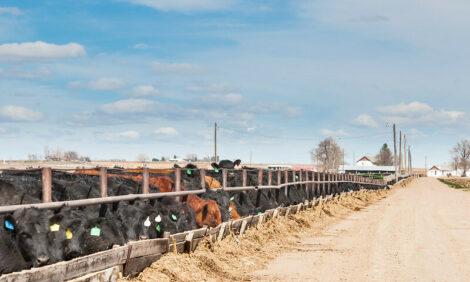



Food Labelling and Veterinary Involvement Key to Providing Food Chain Transparency
GLOBAL - The veterinary profession has just as important a role to play in promoting high farm animal welfare to the consumer as it does in helping to drive improvements on farm.
This was one of the main messages delivered to the veterinary profession at the sixth Boehringer Ingelheim Expert Forum on Farm Animal Well-Being in Bilbao, Spain.
Nearly 100 vets attending the forum were advised that clearer food labelling and greater involvement by vets in the farm auditing and advisory process would help meet growing consumer demands for transparency in the food chain.
“Vets have a real opportunity to affect the well-being of farm animals,” commented Laurent Goby, global brand manager for the NSAID, Metacam.
“By promoting health and well-being on farm, and providing the consumer with clear information on animal well-being, this will help drive sales of high welfare products.”
Pharmaceutical company Boehringer Ingelheim, organisers of the forum, believes it also has a part to play in maintaining the well-being of animals.
“We are deeply involved in the pain management of farm animals and we keep developing new uses for Metacam to restore the well-being of farm animals,” explained Dr Goby.
Sean Wensley (Senior veterinary surgeon at the People’ Dispensary for Sick Animals (PDSA), UK) said vets could step forward and lead the way in educating consumers on the welfare of farmed animals, while promoting higher welfare assurance schemes.
Such an attitude was relevant across the world, but the UK had already demonstrated the influence of food standards labelling on shopper purchasing habits.
“Labelling does help drive sales,” said Mr Wensley. “For example between 2006 and 2011 the number of broilers reared to Freedom Foods Standards in the UK went up 60 per cent while pigs reared to the same standard increased by 84 per cent . If the consumer is better informed, it can affect demand.”
With vets acting as trusted voices on animal welfare on a global scale, they have a vital role in pushing such a trend in high welfare food sales.
And there were already examples where UK vet organisations had taken the lead in selecting high welfare produce.
But vets still had a significant job to increase welfare at farm level. Dr Francesco Testa (Bovine practitioner for the technical services for farmers, Bergamo, Italy), said vets were ideally positioned to help dairy producers achieve high welfare on farm.
“There is a real opportunity for vets to perform farm audits,” he said. “Welfare is a source of income for veterinary clients and the vet is a key person to give advice on animal welfare.”
Dr Testa explained how welfare audits carried out by the Technical Service to Farms (SATA) in Lombardy in Italy had helped dairy farmers target areas for improvement.
He urged vets to look at all the aspects affecting cow welfare when going on farm for routine checks.
“Farmers listen very carefully to vets. This is a good opportunity for vets to share technical advice,” he said.
And holding farm meetings was also a practical and effective way of communicating the animal welfare benefits of making management changes on farm.
Melkwel Project - Begium Milk Marketing
The Melkwel project in the Flanders region of Belgium is also implementing on-farm audits as part of work looking at the potential to use welfare as a marketing strategy for milk.
A number of dairy farms are being assessed using the Welfare Quality protocol for assessing cattle welfare. This looks at widely applicable animal-based measures for establishing welfare.
“Animal-based measures are more closely linked to the actual welfare status of an animal, than resource based measures,” said Sophie de Graaf (Institute of Agriculture and Fisheries Research (ILVO) and Ghent University, Belgium).
Information is collected around four principles; good feeding, good housing, good health and appropriate behaviour. “Appropriate measures are selected based on repeatability, feasibility and validity,” said Ms de Graaf.
US - Global Animal Partnership
In North America, a multi-tiered animal welfare rating program is already helping to promote improvements in farm animal welfare, while allowing the consumer to make informed buying choices.
Miyun Park (executive director of Global Animal Partnership, USA), explained how Global Animal Partnership is an example of multi-stakeholders working together to boost animal welfare. They had worked together to produce the 5-Step Animal Welfare Rating program.
“Each Step rating has its own distinct label affixed on products that identifies the particular Step level achieved,” said Ms Park.
EU Labelling - Lack of Clarity
However, Dr David C J Main (Department of Clinical Veterinary Science, University of Bristol, UK), explained how the current wide range of European food labelling surrounding animal welfare left many consumers confused and frustrated in their choices.
In the UK alone one product could contain a number of different logos, he said. “For example products can be labelled as adhering to certain assurance or organic schemes, and they may be labelled according to method of production or include higher welfare marketing claims.
“Part of the recommendations in The EU Strategy for the Protection and Welfare of Animals 2012-2015 was to improve customer information and their empowerment,” he explained.
And although he recognised labelling was, and would remain complicated, he said there could be some key changes in the future. For example, mandatory method of production labelling could be extended beyond laying hens.
Currently, a lack of standardization also meant it was difficult to promote trade in equivalent higher welfare products, he said.
In the future it may also be possible for animal welfare focused schemes to agree a voluntary international standard based upon best practice principles that would be applicable in any country, he said.
| TheCattleSite News Desk | Read more Boehringer Ingelheim News here |


